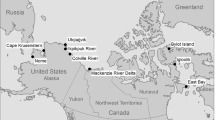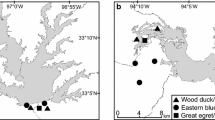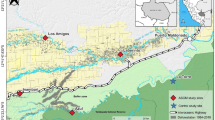Abstract
Mercury pollution is a global problem and of particular concern in high emissions areas, such as China. We studied the migratory Kentish Plover, Charadrius alexandrinus, which breeds in coastal northern/central China and the inland Qinghai Lake, and the White-faced Plover C. dealbatus, a year-round resident of coastal southern China. We measured total mercury (THg) concentrations in feather and blood samples of breeding females. We expected low levels at the remote Qinghai Lake, but we found instead that feather THg concentrations were highest there (3.89 ± 1.53 [SD] μg/g DW [n = 34]; compared to 1.29 ± 0.61 μg/g of Kentish Plover elsewhere [n = 35] and 2.08 ± 1.45 μg/g for White-faced Plover [n = 56]), a result is consistent over 2 years. When including only coastal populations in the analysis, there were no differences in THg concentrations between the two species, although White-faced Plover had more variation. Feather THg concentrations for the coastal populations are similar to other studies on plovers and sandpipers globally, with most birds under the threshold of adverse effects (3 μg/g, an estimate that itself may be too low). Nevertheless, the Qinghai Kentish Plover population has mean feather concentrations above this threshold, indicating high exposure during the nonbreeding season, and some individuals have extreme values (e.g., a bird with a blood level of 7.63 μg/g DW from Zhanjiang, south China), so further research and monitoring are needed.



Similar content being viewed by others
References
Abeysinghe KS, Qiu G, Goodale E, Anderson CW, Bishop K, Evers DC, Goodale MW, Hintelmann H, Liu S, Mammides C, Quan RC, Wang J, Wu P, Xu XH, Yang XD, Feng X (2017) Mercury flow through an Asian rice-based food web. Environ Pollut 229:219–228
Ackerman JT, Herzog MP, Schwarzbach SE (2013) Methylmercury is the predominant form of mercury in bird eggs: A synthesis. Environ Sci Technol 47:2052–2060
Bai Q, Chen J, Chen Z, Dong G, Dong J, Dong W, Fu V, Han Y, Lu G, Li J, Liu Y, Lin Z, Meng D, Martinez J, Ni G, Shan K, Sun R, Tian S, Wang F, Xu Z, Yu Y, Yang J, Yang Z, Zhang L, Zhang M, Zeng X (2015) Identification of coastal wetlands of international importance for waterbirds: a review of China Coastal Waterbird Surveys 2005-2013. Avian Res 6:12
Burger J, Tsipoura N, Niles L, Gochfeld M, Dey A, Mizrahi D (2015) Mercury, lead, cadmium, arsenic, chromium and selenium in feathers of shorebirds during migrating through Delaware Bay, New Jersey: comparing the 1990s and 2011/2012. Toxics 3:63–74
Chen W, Zhang C, Pan T, Liu W, Li K, Hu C, Chang Q (2018) The mitochondrial genome of the Kentish Plover Charadrius alexandrinus (Charadriiformes: Charadriidae) and phylogenetic analysis of Charadrii. Genes Genomics 40:955–963
Cheng H, Hu Y (2010) China needs to control mercury emissions from municipal solid waste (MSW) incineration. Environ Sci Technol 44:7994–7995
Cramp S, Simmons KL, B D, Collar N, Dunn E, Gillmor R, Hollom P, Hudson R, Nicholson E, Ogilvie M (1983) Handbook of the birds of Europe, the Middle East and North Africa. In: The birds of the Western Palearctic: 3. Waders to gulls. Oxford University Press, Oxford
Cristol DA, Brasso RL, Condon AM, Fovargue RE, Friedman SL, Hallinger KK, White AE (2008) The movement of aquatic mercury through terrestrial food webs. Science 320:335–335
Dauwe T, Bervoets L, Pinxten R, Blust R, Eens M (2003) Variation of heavy metals within and among feathers of birds of prey: effects of molt and external contamination. Environ Pollut 124:429–436
Eagles-Smith CA, Ackerman JT, De La Cruz SE, Takekawa JY (2009) Mercury bioaccumulation and risk to three waterbird foraging guilds is influenced by foraging ecology and breeding stage. Environ Pollut 157:1993–2002
Evers DC, Burgess NM, Champoux L, Hoskins B, Major A, Goodale WM, Taylor RJ, Poppenga R, Daigle T (2005) Patterns and interpretation of mercury exposure in freshwater avian communities in northeastern North America. Ecotoxicology 14:193–221
Fernández G, García-Hernández J, Cruz-Acevedo E, Castillo-Guerrero JA (2018) Patterns of mercury accumulation in tissues of Western sandpipers (Calidris mauri) wintering on the coast of Sinaloa, Mexico. Waterbirds 41:438–443
Fu X, Feng X, Zhang G, Xu W, Li X, Yao H, Liang P, Li J, Sommar J, Yin R, Liu N (2010) Mercury in the marine boundary layer and seawater of the South China Sea: concentrations, sea/air flux, and implication for land outflow. J Geophys Res Atmos 115(D6)
Fuchsman PC, Brown LE, Henning MH, Bock MJ, Magar VS (2017) Toxicity reference values for methylmercury effects on avian reproduction: critical review and analysis. Environ Toxicol Chem 36:294–319
Furness RW, Muirhead SJ, Woodburn M (1986) Using bird feathers to measure mercury in the environment relationships between mercury content and moult. Pollut Bull 17:27–30
Ge Z, Wang T, Zhou X, Shi W (2006) Seasonal change and habitat selection of shorebird community at the South Yangtze River Mouth and North Hangzhou Bay, China. Acta Ecol Sin 26:40–47
Hall LK, Cavitt JF (2012) Comparative study of trapping methods for ground-nesting shorebirds. Waterbirds 35:342–346
Hargreaves AL, Whiteside DP, Gilchrist G (2010) Concentrations of 17 elements, including mercury, and their relationship to fitness measures in arctic shorebirds and their eggs. Sci Total Environ 408:3153–3161
Hobson KA (1999) Tracing origins and migration of wildlife using stable isotopes: a review. Oecologia 120:314–326
Huang Y, Deng M, Li T, Japenga J, Chen Q, Yang X, He Z (2017) Anthropogenic mercury emissions from 1980 to 2012 in China. Environ Pollut 226:230–239
Hui CA, Takekawa JY, Warnock SE (2001) Contaminant profiles of two species of shorebirds foraging together at two neighboring sites in south San Francisco Bay, California. Environ Monit Assess 71:107–121
Jackson AK, Evers DC, Etterson MA, Condon AM, Folsom SB, Detweiler J, Schmerfeld J, Cristol DA (2011) Mercury exposure affects the reproductive success of a free-living terrestrial songbird, the Carolina Wren (Thryothorus ludovicianus). Auk 128:759–769
Kennerley PR, Bakewell DN, Round PD (2008) Rediscovery of a long-lost Charadrius plover from South-East Asia. Forktail 24:63–79
Lavoie RA, Jardine TD, Chumchal MM, Kidd KA, Campbell LM (2013) Biomagnification of mercury in aquatic food webs: a worldwide meta-analysis. Environ Sci Technol 47:13385–13394
Lindberg P, Odsjo T (1983) Mercury levels in feathers of Peregrine Falcon Falco peregrinus compared with total mercury content in some of its prey species in Sweden. Environ Pollut B 5:297–318
Liu D, Zhang G, Jiang H, Lu J (2018a) Detours in long-distance migration across the Qinghai-Tibetan Plateau: individual consistency and habitat associations. PeerJ 6:e4304
Liu Y, Liu S, Yeh CF, Zhang N, Chen G, Que P, Dong L, Li SH (2018b) The first set of universal nuclear protein-coding loci markers for avian phylogenetic and population genetic studies. Sci Rep 8:1–12
Ma ZJ, Jing K, Tang SM, Chen JK (2002) Shorebirds in the eastern intertidal areas of Chongming Island during the 2001 northward migration. Stilt 41:6–10
Ma Y, Branfireun BA, Hobson KA, Guglielmo CG (2018a) Evidence of negative seasonal carry-over effects of breeding ground mercury exposure on survival of migratory songbirds. J Avian Biol 49:jav-01656
Ma Y, Perez CR, Branfireun BA, Guglielmo CG (2018b) Dietary exposure to methylmercury affects flight endurance in a migratory songbird. Environ Pollut 234:894–901
Mabee TJ, Wildman AM, Johnson CB (2006) Using egg flotation and eggshell evidence to determine age and fate of Arctic shorebird nests. J Field Ornithol 77:163–172
McKinney CR, McCrea JM, Epstein S, Allen HA, Urey HC (1950) Improvements in mass spectrometers for the measurement of small differences in isotope abundance ratios. Rev Sci Instrum 21:724–730
Mergler D, Anderson HA, Chan LHM, Mahaffey KR, Murray M, Sakamoto M, Stern AH (2007) Methylmercury exposure and health effects in humans: a worldwide concern. AMBIO 36:3–11
Pacyna EG, Pacyna JM, Sundseth K, Munthe J, Kindbom K, Wilson S, Steenhuisen F, Maxson P (2010) Global emission of mercury to the atmosphere from anthropogenic sources in 2005 and projections to 2020. Atmos Environ 44:2487–2499
Pacyna JM, Travnikov O, Simone FD, Hedgecock IM, Sundseth K, Pacyna EG, Steenhuisen F, Pirrone N, Munthe J, Kindbom K (2016) Current and future levels of mercury atmospheric pollution on a global scale. Atmos Chem Phys 16:12495–12511
Perkins M, Ferguson L, Lanctot RB, Stenhouse IJ, Kendall S, Brown S, Gates HR, Hall JO, Regan K, Evers DC (2016) Mercury exposure and risk in breeding and staging Alaskan shorebirds. Condor 118:571–582
Peterson SH, Ackerman JT, Toney M, Herzog MP (2019) Mercury concentrations vary within and among individual bird feathers: a critical evaluation and guidelines for feather use in mercury monitoring programs. Environ Toxicol Chem 38:1164–1187
Post DM (2002) Using stable isotopes to estimate trophic position: models, methods, and assumptions. Ecology 83:703–718
Que P, Chang Y, Eberhartphillips LJ, Liu Y, Szekely T, Zhang Z (2015) Low nest survival of a breeding shorebird in Bohai Bay, China. J Ornithol 156:297–307
Que P, Székely T, Wang P, Lu Q, Lei W, Liu Y, Zhang Z (2019) Offspring sex ratio is unrelated to parental quality and time of breeding in a multiple-breeding shorebird. J Ornithol 160:443–452. https://doi.org/10.1007/s10336-018-1620-6
Rheindt FE, Székely T, Edwards SV, Lee PL, Burke T, Kennerley PR, Bakewell DN, Alrashidi M, Kosztolányi A, Weston MA, Liu WT, Lei WP, Shigeta Y, Javed S, Zefania S, Küpper C (2011) Conflict between genetic and phenotypic differentiation: the evolutionary history of a ‘lost and rediscovered’ shorebird. PLoS One 6:e26995
Scheuhammer AM, Meyer MW, Sandheinrich MB, Murray MW (2007) Effects of environmental methylmercury on the health of wild birds, mammals, and fish. AMBIO 36:12–19
Seewagen CL (2018) The threat of global mercury pollution to bird migration: potential mechanisms and current evidence. Ecotoxicology:1–14
Seewagen CL, Cristol DA, Gerson AR (2016) Mobilization of mercury from lean tissues during simulated migratory fasting in a model songbird. Sci Rep 6:25762
Seewagen CL, Ma Y, Morbey YE, Guglielmo CG (2019) Stopover departure behavior and flight orientation of spring-migrant Yellow-rumped Warblers (Setophaga coronata) experimentally exposed to methylmercury. J Ornithol 160:617–624. https://doi.org/10.1007/s10336-019-01641-2
Solonen T, Lodenius M (1984) Mercury in Finnish Sparrowhawks Accipiter nisus. Ornis Fenn 61:58–63
Streets DG, Hao J, Wu Y, Jiang JS, Chan M, Tian H, Feng X (2005) Anthropogenic mercury emissions in China. Atmos Environ 39:7789–7806
Tang Z, Huang Q, Nie Z, Yang Y (2015) Pollution threatens migratory shorebirds. Science 350:1176–1177
Tsipoura N, Burger J, Niles L, Dey A, Gochfeld M, Peck M, Mizrahi D (2017) Metal levels in shorebird feathers and blood during migration through Delaware Bay. Arch Environ Contam Toxicol 72:562–574
Ullrich SM, Tanton TW, Abdrashitova SA (2001) Mercury in the aquatic environment: a review of factors affecting methylation. Crit Rev Environ Sci Technol 31:241–293
Vincze O, Kosztolányi A, Barta Z, Küpper C et al (2017) Parental cooperation in a changing climate: fluctuating environments predict shifts in care division. Glob Ecol Biogeogr 26:347–358
Wang SX, Zhang L, Li GH, Wu Y, Hao JM, Pirrone N, Sprovieri F, Ancora MP (2010) Mercury emission and speciation of coal-fired power plants in China. Atmos Chem Phys 10:1183–1192
Wang D, Zheng S, Wang P, Matsiko J, Sun H, Hao Y, Li Y, Zhang Z, Que P, Meng D, Zhang Q, Jiang G (2019a) Effects of migration and reproduction on the variation in persistent organic pollutant levels in Kentish Plovers from Cangzhou Wetland, China. Sci Total Environ. https://doi.org/10.1016/j.scitotenv.2019.03.039
Wang X, Que P, Heckel G, Hu J, Zhang X, Chiang CY, Huang Q, Liu S, Martinez J, Zhang N, Pagani-Núñez E, Dingle C, Leung YY, Székely T, Zhang Z, Liu Y (2019b) Genetic, phenotypic and ecological differentiation suggests incipient speciation in two Charadrius plovers along the Chinese coast. BMC Evol Biol 19:135. https://doi.org/10.1186/s12862-019-1449-5
Wang X, Maher KH, Zhang N, Que P, Zheng C, Liu S et al (2019c) Demographic histories and genome-wide patterns of divergence in incipient species of shorebirds. Front Genet. https://doi.org/10.3389/fgene.2019.00919
Whitney MC, Cristol DA (2017) Impacts of sublethal mercury exposure on birds: a detailed review. Rev Environ Contam Toxicol 244:113–163
Wilcove DS, Wikelski M (2008) Going, going, gone: is animal migration disappearing? PLoS Biol 7:e188
Wolfe MF, Schwarzbach S, Sulaiman RA (1998) Effects of mercury on wildlife: a comprehensive review. Environ Toxicol Chem 17:146–160
Zamani-Ahmadmahmoodi R, Esmaili-Sari A, Savabieasfahani M, Ghasempouri SM, Bahramifar N (2010) Mercury pollution in three species of waders from Shadegan wetlands at the head of the Persian Gulf. Bull Environ Contam Toxicol 84:326–330
Zhang L, Wong MH (2007) Environmental mercury contamination in China: sources and impacts. Environ Int 33:108–121
Zheng S, Wang P, Sun H, Matsiko J, Hao Y, Meng D, Li Y, Zhang G, Zhang Q, Jiang G (2018) Tissue distribution and maternal transfer of persistent organic pollutants in Kentish Plovers (Charadrius alexandrinus) from Cangzhou Wetland, Bohai Bay, China. Total Environ 612:1105–1113
Acknowledgments
We are grateful for the approval of the field samples from the appropriate authorities. Special thanks to Shaochong Peng for preparing sketches of plovers in Fig. 1 and also Halimubieke Naerhulan for sharing his unpublished data of nesting success of Kentish Plover at Qinghai Lake and for his comments on an earlier draft of the manuscript. We thank a total of five anonymous reviewers for their criticisms which substantially improved subsequent drafts of the manuscript. Fieldwork for this study was supported by the National Natural Science Foundation of China [NNSFC] (grants 31301875 and 31572251) to YL, and NNSFC (grant 31600297) to PQ. Additional field work was supported by the Special Talents Recruitment Program of Guangxi University to EG. Laboratory work for this study was supported by NNSFC (grant 41301557) and “Chen Guang” project (grant 14CG17) of Shanghai Municipal Education Commission and Shanghai Education Development Foundation to RW. TPS was supported by a Guangxi Postdoctoral Grant during write-up.
Author information
Authors and Affiliations
Corresponding authors
Ethics declarations
Ethics statement
This study did not involve endangered or protected species of the People’s Republic of China. The sampling protocol of our study was reviewed and approved by the Institutional Ethical Committee of Animal Experimentation of Sun Yat-sen University (2005DKA21403-JK). We strictly complied with the ethical conditions of the Chinese Animal Welfare Act (20090606). Permission from the respective authorities was supervised by Beijing Normal University for Kentish Plover study locations and by Sun Yat-sen University for White-faced Plover locations.
Additional information
Responsible editor: Gangrong Shi
Publisher’s note
Springer Nature remains neutral with regard to jurisdictional claims in published maps and institutional affiliations.
Rights and permissions
About this article
Cite this article
Su, T., Lin, X., Huang, Q. et al. Mercury exposure in sedentary and migratory Charadrius plovers distributed widely across China. Environ Sci Pollut Res 27, 4236–4245 (2020). https://doi.org/10.1007/s11356-019-06873-6
Received:
Accepted:
Published:
Issue Date:
DOI: https://doi.org/10.1007/s11356-019-06873-6




